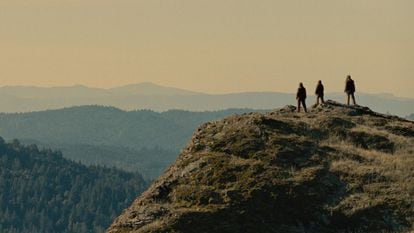Non-human narrators come to auteur cinema. Several titles presented at the Berlinale, which will end this Saturday with the announcement of the official winners, have adopted the point of view of rhinos, hominids and works of art stolen in the colonial era. The same thing has happened, for some time now, in current literature, in which more and more writers, using the narrative resources of fables, tell their stories as if the flora, fauna, geographical features and inanimate objects They had the faculty of human language.
Of all these films, the best is titled Dahomey. Behind the museum display case, in the darkness of a room where the lights have suddenly gone out, as in a prison at nightfall, an inanimate effigy begins to speak. It is part of the 26 works stolen by France in the 19th century from the kingdom of Dahomey, about to be returned to their place of origin, in current Benin, the first restitution promoted by Emmanuel Macron, who in 2018 promised a general return of the funds stolen by the colonial army. Restorative justice or self-serving gesture to preserve French influence in the area? It is one of the questions raised by the documentary by Mati Diop, a Franco-Senegalese director who entered everyone’s radar by winning the Grand Prix in Cannes with an applauded debut, tinged with postcolonial sensitivity, which she titled Atlantic.
At first, his second film has a modest appearance: it limits itself to following, at a safe distance, the return of those works, statuettes of half-human and half-animal divinities, and to filming the debates that this return home generated in an assembly made up of young university students from Cotonou, which was convened by the director herself. Without hiding behind a false equanimity, Diop gives the floor only to those Beninese, who make it clear that restitution is not only a symbolic compensation after centuries of extractivism and other oppressions, but a fundamental act to reconstruct a cultural imaginary that has barely survived. . “I grew up with Disney, but not with these statues,” says one. That’s what cinema is also for, among other less important things.
Dahomey It is not only a document, but also a poetic gesture. The director alternates the documentary images of this return trip with a beautiful narration, written by the Haitian author Makenzy Orcel, who pretends to adopt the point of view of one of those inanimate objects. It is a dark and deep voice, as if passed through the synthetic sieve of a vocoder, which reflects on memory and exile. The documentary is only 67 minutes long. Too much little for the Golden Bear? It would be a mistake to leave out the best film seen in a dull and forgettable competition from the list of winners.
‘Dahomey’ makes it clear that the restitution of African art is not only a symbolic compensation, but a fundamental act to reconstruct a cultural imaginary. That’s what cinema is also for.
Incredible but true: the improbable voice of that African work of art is very similar to that of one of the hippos that were part of Pablo Escobar’s private zoo, about 200 kilometers from Medellín. The animal is the protagonist of Pepea delirious biography of that pachyderm, which is dedicated to narrating his life from his birth in Africa until his death in 2009, when he was trying to escape from the drug trafficker’s ranch as if he were one of those maroons who, centuries ago, wanted to leave behind their slave status.
The Dominican Nelson Carlo de los Santos signs one of the most original and free titles in the competition, which is also a relative disappointment. His main virtue consists of inventing a non-transferable cinematographic language, tailor-made for his film, and experimenting with it in almost every shot, even when that leads to failure. The director loses himself and finds himself several times throughout an unusual and imperfect film, but also fiercely alive, which speaks, according to the person responsible for it, of the “circularity of coloniality”, a circumstance from which it is very difficult to escape.

Sasquatch Sunset is the new thing from the Zellner brothers, who have just directed the series The Curse. Presented out of competition, the film also invents a language, even if it is only based on grunts, for a family of Bigfoot or Big feet, those hominid primates once seen in the mountains of North America. There is not a single intelligible dialogue in the film, which does not prevent it from surprising, moving and urging reflection, in addition to demonstrating that cinema mainstream is still not entirely incapable of contributing an iota of fantasy and formal freedom to this medium.
Heir to that cinema of other decades that showed a pronounced fascination with apes – only this time in a moderately indie—, Sasquatch Sunset It is a film as basic as it is endearing, which brilliantly uses the codes of silent cinema and the physical humor of the beginnings of the seventh art to describe how that first cousin of the yeti learned what affection, love, sex, death consisted of. and pain (or, in short, how he learned to be human). The film questions a quintessentially American theme, which is becoming increasingly universal, in light of the latest planetary events: the possibility of starting over, of returning to that moment when the landscape was virgin and civilization had not yet It was a quagmire. What a time those were, if they ever existed.
All the culture that goes with you awaits you here.
Babelia
The literary news analyzed by the best critics in our weekly newsletter
RECEIVE IT
_




